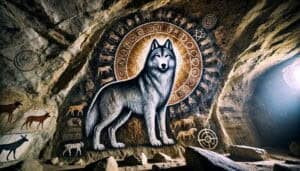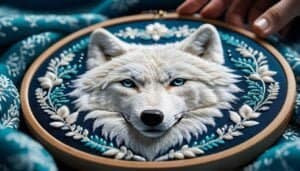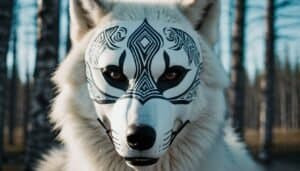Introduction
Arctic wolves have long inspired the clothing and textile traditions of Arctic Indigenous peoples
From fur-lined garments that provide warmth and protection to intricate embroidery and beadwork depicting wolf motifs, these designs reflect the cultural, spiritual, and practical significance of wolves in Arctic life
Arctic wolves symbolize strength, resilience, and harmony with nature, qualities that are woven into the fabrics and stories of traditional clothing
This article explores how Arctic wolves are represented in traditional Arctic clothing and textiles, the materials and techniques used, and the enduring cultural significance of these designs
The Representation of Arctic Wolves in Traditional Clothing
Arctic Indigenous clothing often incorporates the imagery and materials of Arctic wolves, reflecting their cultural and spiritual significance. These garments serve both practical and symbolic purposes, honoring the wolf’s strength, resilience, and connection to the Arctic environment
Use of Wolf Fur in Arctic Indigenous Garments
Wolf fur is a prized material in traditional Arctic clothing, valued for its durability, warmth, and ability to resist frost accumulation
The fur is often used to line the edges of parkas, mittens, and boots, providing critical insulation in subzero temperatures. Arctic wolves’ dense and water-resistant pelts make them ideal for these applications
Reed (2018) noted that the use of wolf fur is guided by principles of sustainability and respect. Indigenous hunters ensure that every part of the animal is utilized, reflecting a cultural ethos of minimizing waste. Beyond its practicality, wolf fur carries symbolic weight, representing the animal’s protective and resilient qualities, which are transferred to the wearer
In ceremonial garments, wolf pelts are often used to signify leadership or spiritual authority. For instance, the pelts may be worn as cloaks or draped over the shoulders during rituals, emphasizing the wolf’s role as a guardian and guide
Symbolism of Wolf Motifs in Textiles and Embroidery
Wolf motifs frequently appear in the embroidery, beadwork, and patterns of Arctic Indigenous textiles
These designs are more than decorative—they convey stories, values, and spiritual beliefs tied to the wolf’s role in the community and environment. The motifs often depict wolves in dynamic poses, such as howling or running, symbolizing communication, freedom, and endurance
Hanson et al. (2020) documented how these motifs vary between communities, with some focusing on realistic depictions of wolves and others using abstract or stylized designs. Regardless of style, the imagery serves as a reminder of the wolf’s importance in Arctic mythology and daily life
In many cases, the placement of wolf motifs on clothing is intentional. For example, wolves may be embroidered on the chest or back of a parka to invoke protection or guidance, reinforcing the wearer’s spiritual connection to the animal
The Role of Arctic Wolves in Ceremonial Clothing
Ceremonial clothing often incorporates Arctic wolf imagery to reflect the animal’s spiritual significance
Shamans and spiritual leaders may wear garments adorned with wolf fur or motifs during rituals to channel the wolf’s energy and connect with the spirit world. These garments often include additional symbolic elements, such as beads or carvings, that enhance their spiritual power
Walker (2021) observed that ceremonial clothing featuring wolf imagery is also used in community gatherings, such as celebrations of the changing seasons or rites of passage. These garments not only honor the wolf’s role as a guardian but also reinforce the community’s relationship with the natural world
Through their use of fur, motifs, and ceremonial designs, Arctic Indigenous clothing reflects the deep respect and reverence for wolves as symbols of survival, protection, and harmony. These garments serve as tangible expressions of the bond between humans and the Arctic’s most iconic predators
Techniques and Materials Used in Arctic Wolf-Inspired Textiles
The incorporation of Arctic wolf imagery and materials into traditional clothing is achieved through a combination of skilled craftsmanship, cultural knowledge, and sustainable practices
These techniques preserve the wolf’s symbolic and functional significance while reflecting the ingenuity of Arctic Indigenous peoples
Traditional Methods of Integrating Wolf Imagery into Clothing
Arctic Indigenous artisans use various traditional methods to integrate wolf imagery into clothing, including embroidery, beadwork, and appliqué. These techniques allow for detailed representations of wolves, from realistic depictions to abstract designs symbolizing the animal’s traits
Embroidery is often performed using sinew or modern thread, with patterns carefully planned to reflect the wolf’s spiritual role. Beadwork, a common embellishment on ceremonial garments, uses natural materials such as bone, shell, or seeds, alongside contemporary glass beads, to create intricate wolf designs
These motifs may depict the wolf howling under the moon, running across the tundra, or in symbolic forms that convey strength and resilience
Reed (2018) highlighted that the placement of these designs is deliberate, aligning with the spiritual purpose of the garment. For example, wolf designs may be concentrated on the shoulders or chest to signify protection and guidance
Balancing Conservation and Cultural Practices
The use of Arctic wolf fur in clothing requires careful consideration to ensure sustainable practices. Indigenous communities have long balanced their cultural traditions with ecological stewardship, using only what is necessary and respecting the wolf’s role in the ecosystem
Hunting practices are guided by traditional knowledge, with specific rituals performed to honor the wolf’s spirit. These rituals often involve prayers or offerings, ensuring that the animal’s sacrifice is respected
Additionally, efforts are made to use every part of the animal, from its fur and bones to its sinew, reducing waste and maximizing utility
Walker (2020) emphasized that many Indigenous communities are adapting their practices in response to modern conservation concerns. For instance, some artisans are using ethically sourced or substitute materials for ceremonial garments to reduce the impact on local wolf populations
These adaptations demonstrate a commitment to preserving both cultural traditions and wildlife
Modern Adaptations of Arctic Wolf Designs
As Arctic Indigenous communities navigate contemporary challenges, wolf-inspired textiles are evolving to incorporate new materials and methods
Modern adaptations include the use of synthetic fur, machine embroidery, and digital printing to replicate traditional wolf designs. These innovations allow artisans to preserve the aesthetic and symbolic elements of wolf imagery while minimizing environmental impacts
Green (2021) noted that these adaptations also expand the accessibility of Arctic wolf-inspired clothing. For example, younger generations can wear garments featuring wolf motifs that blend traditional and modern styles, ensuring that cultural identity remains vibrant in changing times
Through these techniques and materials, Arctic wolf-inspired textiles continue to reflect the artistry, spirituality, and resilience of Arctic Indigenous peoples. By blending tradition with innovation, communities honor their cultural heritage while addressing the realities of a rapidly changing world
Cultural Significance of Arctic Wolf Imagery in Clothing
Arctic wolf imagery in traditional clothing serves as a powerful expression of identity, spirituality, and connection to the natural world
These designs carry deep cultural meanings, reflecting the values and beliefs of Arctic Indigenous communities while preserving their heritage across generations
How Wolf Designs Reflect Identity and Spiritual Beliefs
For Arctic Indigenous peoples, clothing adorned with wolf motifs represents more than artistic expression; it is a testament to their cultural identity and spiritual connection to the Arctic environment
Wolves are revered as symbols of strength, adaptability, and guardianship, qualities that resonate deeply with the challenges and values of life in the tundra
Hanson et al. (2020) observed that garments featuring wolf imagery often signify personal or communal traits, such as leadership, protection, or harmony with nature. For example, a hunter might wear clothing with wolf designs to invoke the animal’s prowess and cunning, while a spiritual leader may use similar imagery to represent their role as a guide and protector
These motifs also serve as reminders of the interdependence between humans and the natural world, emphasizing respect and gratitude for the animals that sustain Arctic communities
Regional Variations in Depicting Arctic Wolves in Textiles
The representation of Arctic wolves in clothing varies across regions, reflecting the unique traditions and aesthetics of different Arctic Indigenous groups
Some communities favor realistic depictions of wolves, capturing their physical characteristics in detailed embroidery or beadwork. Others use abstract or symbolic designs, incorporating geometric patterns or stylized forms that evoke the wolf’s spirit rather than its physical appearance
Johnson (2019) highlighted that regional differences often stem from local resources, environmental conditions, and cultural narratives. For example, communities with abundant access to wolf populations may use fur more prominently in their garments, while others rely on symbolic representations crafted from alternative materials
These regional variations showcase the diversity and richness of Arctic Indigenous textile traditions, demonstrating how wolf imagery is adapted to reflect specific cultural and environmental contexts
Preserving Arctic Wolf Imagery in Contemporary Textile Art
In modern times, Arctic Indigenous artists are finding new ways to preserve and reinterpret wolf imagery in clothing and textiles. By blending traditional techniques with contemporary materials and styles, these artists ensure that wolf symbolism remains a vibrant part of Arctic cultural expression
Green (2021) noted that many artists incorporate wolf motifs into wearable art, such as modern parkas, scarves, or jewelry, allowing younger generations to connect with their heritage in accessible and innovative ways
Digital tools, such as graphic design software, are also being used to create wolf-inspired patterns that can be printed onto fabrics or integrated into mass-produced items
These efforts not only keep traditional wolf imagery alive but also introduce Arctic Indigenous art to global audiences, fostering greater appreciation for the cultural and spiritual significance of wolves in Arctic life
Through their symbolic meanings, regional diversity, and modern adaptations, Arctic wolf designs in clothing continue to reflect the enduring relationship between Arctic Indigenous peoples and their environment
These garments are more than functional items—they are living expressions of culture, spirituality, and resilience
Conclusion
The depiction of Arctic wolves in traditional Arctic clothing and textiles reflects the deep cultural and spiritual connections Indigenous communities have with these animals
From the use of wolf fur in garments to intricate embroidery and beadwork, these designs symbolize protection, resilience, and harmony with nature, serving as both practical and ceremonial expressions of identity and belief
Through skilled craftsmanship and sustainable practices, Arctic Indigenous peoples honor the wolf’s role as a guardian and guide. Regional variations and modern adaptations demonstrate the dynamic nature of these traditions, ensuring they remain relevant while addressing conservation and environmental challenges
By preserving and reinterpreting wolf imagery in clothing and textiles, Arctic Indigenous communities maintain their cultural heritage, inspire younger generations, and share their profound respect for the natural world with a global audience
These garments serve as powerful reminders of the interconnectedness of humans, animals, and the environment in the Arctic











